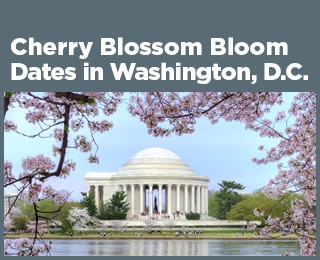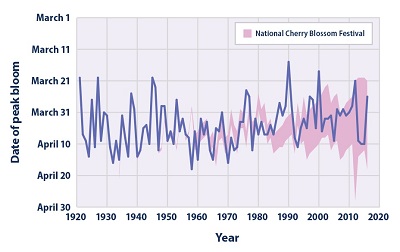|
|
| |
|
|
| |
|
|
| Cherry Blossom Bloom Dates in Washington, D.C. |
|
| |
 Community Connection: Cherry Blossom
Bloom Dates in Washington, D.C. Community Connection: Cherry Blossom
Bloom Dates in Washington, D.C.
This feature tracks the annual peak bloom date of
Washington, D.C.’s famous cherry trees.
Key Points
Based on the entire 96 years of data in Figure 1,
Washington’s cherry blossoms reach their peak on April 4 in
an average year. By comparison, the peak bloom date in 2016
was March 25.
Peak bloom date for the cherry trees is occurring earlier
than it did in the past. Since 1921, peak bloom dates have
shifted earlier by approximately five days.
While the length of the National Cherry Blossom Festival has
continued to expand, the Yoshino cherry trees have bloomed
near the beginning of the festival in recent years. During
some years, the festival missed the peak bloom date
entirely. |
|
Background
In Washington, D.C., the arrival of spring brings a splash
of color as the city’s iconic cherry trees burst into bloom.
The city has enjoyed cherry blossoms each year dating back
to 1912, when Japan gave about 3,000 cherry trees to the
United States as a gift of friendship. These trees surround
Washington’s Tidal Basin, and the beautiful blooms set
against the backdrop of the national monuments bring more
than 1.5 million visitors to the area every year during the
National Cherry Blossom Festival. Not surprisingly, the
festival is planned to coincide with the peak bloom of the
cherry trees.
The exact timing of peak bloom varies from year to year, and
it is largely driven by local temperatures during the winter
and early spring. As the Leaf and Bloom Dates indicator
explains, scientists have very high confidence that recent
warming trends in global climate are causing spring events
such as leaf growth and flower blooms to happen earlier. In
the case of Washington’s cherry blossoms, earlier bloom
dates could affect tourism and the local economy.
The peak bloom date for the most common type of cherry tree
around Washington’s Tidal Basin—the Yoshino variety—has been
carefully estimated and recorded since 1921 by the National
Park Service. The peak bloom date is defined as the day when
70 percent of the blossoms are in full bloom.
Figure 1 shows how the peak bloom date of the Yoshino cherry
trees has changed since 1921. It also shows the dates of the
National Cherry Blossom Festival, which has grown to several
weeks as its popularity has expanded. There is considerable
variability in the peak bloom date, which makes predicting
the exact timing difficult. Anticipation of the peak bloom
captivates meteorologists, city planners, the National Park
Service, residents, and tourists each year. |
|
Notes
In addition to winter and early spring temperatures, the
timing of the peak bloom for cherry trees can be affected by
other weather, climate, and location factors. For example,
extended growing periods and warmer autumns could affect
bloom dates by altering other stages of cherry tree growth.
Data Sources
Peak bloom dates and festival dates were provided by the
National Park Service and organizers of the National Cherry
Blossom Festival. Bloom dates and other information about
Washington’s cherry trees can be found online at:
www.nationalcherryblossomfestival.org and:
www.nps.gov/subjects/cherryblossom/index.htm.
Technical Documentation
Download related technical information PDF |
|
 Figure
1. Peak Bloom Date for Cherry Trees Around
Washington, D.C.’s Tidal Basin, 1921–2016 Figure
1. Peak Bloom Date for Cherry Trees Around
Washington, D.C.’s Tidal Basin, 1921–2016
This figure shows the peak bloom date each year for the main
type of cherry tree around the Tidal Basin in Washington,
D.C. The peak bloom date occurs when 70 percent of the
blossoms are in full bloom. The shaded band shows the timing
of the annual National Cherry Blossom Festival. The festival
began in 1934 but was not held during World War II.
Data sources: National Cherry Blossom Festival, 2016;2
National Park Service, 20153 |
|
|
|
EPA Page |
|
This is the
EPA page for this topic. To see if the Trump
administration has changed the EPA page, simply click the
link and compare the information with this page. If you
notice changes were made to the EPA page, please post a
comment. Thanks. |
|
|
|
|
|
|
|
|
|
|
|
|
Additional Climate Change Information |
Climate Change and Carbon Dioxide
(Beginner - Listening,
reading)
A video lesson to
help with your understanding of climate change
and carbon dioxide.
The English is
spoken at 75% of normal speed.
Great English listening and reading practice. |
Carbon Dioxide and Climate Change
(Beginner - Listening,
reading)
A video lesson to
help with your understanding of carbon dioxide
and climate change.
The English is
spoken at 75% of normal speed.
Great English listening and reading practice. |
Environmental Group Warns Earth's Health at Risk
(Beginner - Listening,
reading)
A video lesson to
help with your understanding of climate change.
The English is
spoken at 75% of normal speed.
Great English listening and reading practice.
A report by the World Wildlife Fund looked at thousands of animal populations
and found they have dropped significantly in 40 years. |
Sea Levels Rising at Fastest Rate in 3,000 years
(Beginner - Listening,
reading)
A video lesson to
help with your understanding of climate change.
The English is
spoken at 75% of normal speed.
Great English listening and reading practice.
A group of scientists say sea levels are rising at record rates. Another group
found that January temperatures in the Arctic reached a record high. |
Capturing CO2 Gas Is Not Easy
(Beginner - Listening,
reading)
A video lesson to
help with your understanding of climate change.
The English is
spoken at 75% of normal speed.
Great English listening and reading practice.
Most scientists agree that carbon-dioxide gas is partly to blame for climate
change: rising global temperatures. But capturing the CO2 gas released by power
stations is costly and difficult. |
Growth, Climate Change Threaten African Plants and
Animals
(Beginner - Listening,
reading)
A video lesson to
help with your understanding of climate change.
The English is
spoken at 75% of normal speed.
Great English listening and reading practice.
Researchers believe Africa may lose as much as 30 percent of its animal and
plant species by the end of this century. |
|
|
|
|
Search Fun Easy English |
|
|
|
|
|
|
|
|
|
|
|
|
|
|
|
About
Contact
Copyright
Resources
Site Map |